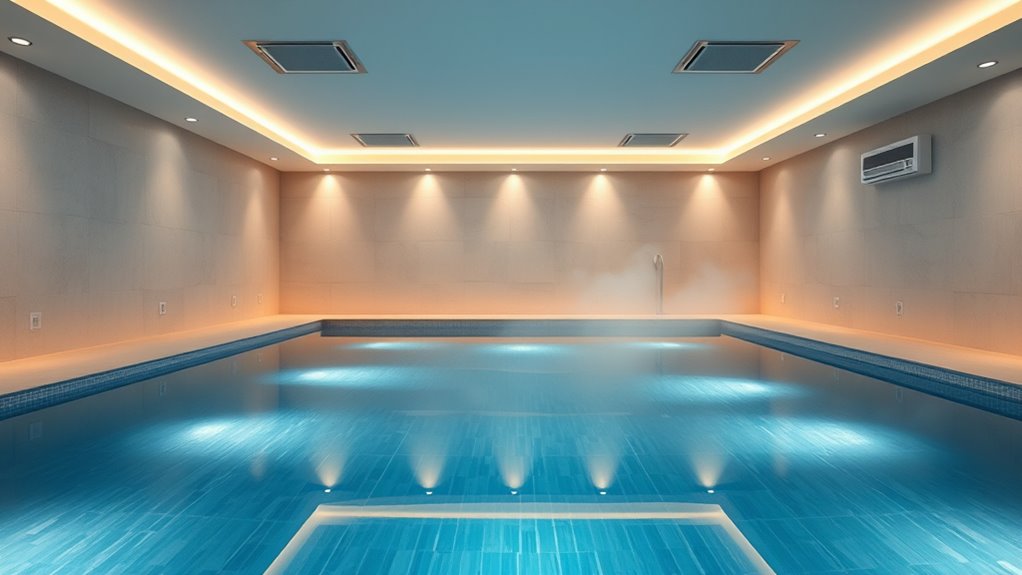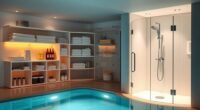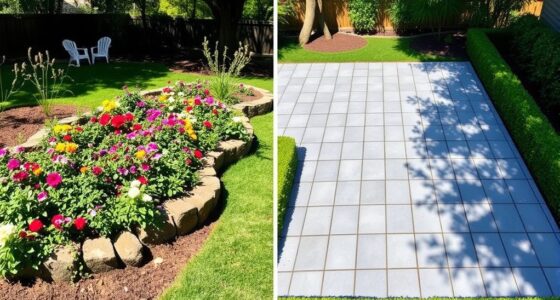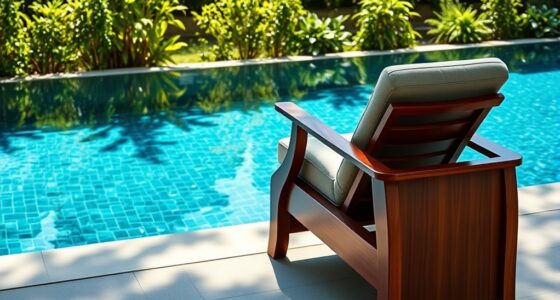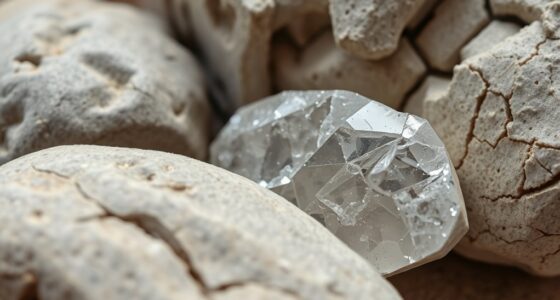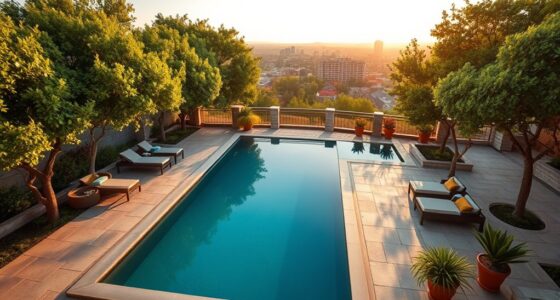To manage moisture and guarantee air quality around your indoor pool, you need effective dehumidification and airflow strategies. Use a properly sized dehumidifier with control systems to regulate humidity, and install vents and exhaust fans to remove excess moisture and odors. Proper placement, maintenance, and monitoring are key for peak performance. If you’re enthusiastic to learn more about maintaining a safe, comfortable indoor pool environment, you’ll find helpful insights beyond this overview.
Key Takeaways
- Proper humidity control prevents mold, structural damage, and discomfort by maintaining levels between 50-60%.
- Dehumidifiers, heat exchangers, and fans are essential components for effective moisture removal and airflow management.
- Strategic placement of ventilation and exhaust fans ensures efficient removal of humidity, odors, and airborne contaminants.
- Regular monitoring of humidity and air quality sensors helps optimize dehumidification and ventilation systems.
- Correct system sizing and maintenance extend equipment lifespan and ensure consistent indoor pool environment quality.
Understanding the Importance of Proper Humidity Control
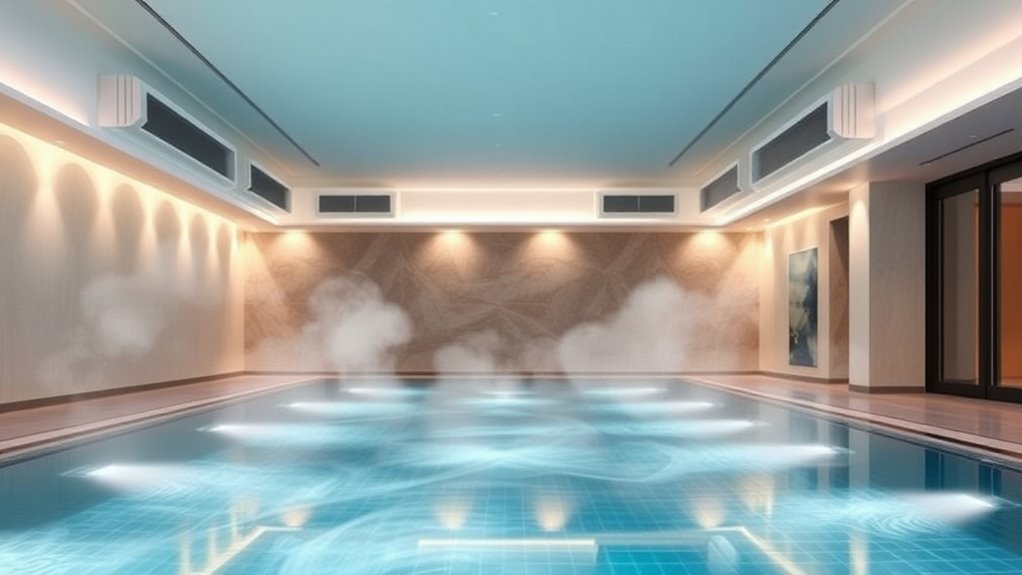
Maintaining proper humidity levels is crucial when you have an indoor pool, as excessive moisture can lead to mold growth, wood warping, and damage to your home’s structure. Too much humidity creates an environment where mold spores thrive, risking health issues and unpleasant odors. It can also cause wooden beams, floors, and furniture to warp or rot over time. High humidity increases condensation on walls, ceilings, and windows, which can lead to water damage and deterioration. Additionally, implementing regular maintenance can help monitor and manage humidity levels effectively. Conversely, low humidity can cause discomfort, dry skin, and respiratory irritation. By controlling humidity levels effectively, you protect your home and ensure a safe, comfortable environment for everyone. Proper humidity management is essential for maintaining your pool area’s health, safety, and longevity.
Key Components of a Pool Dehumidification System
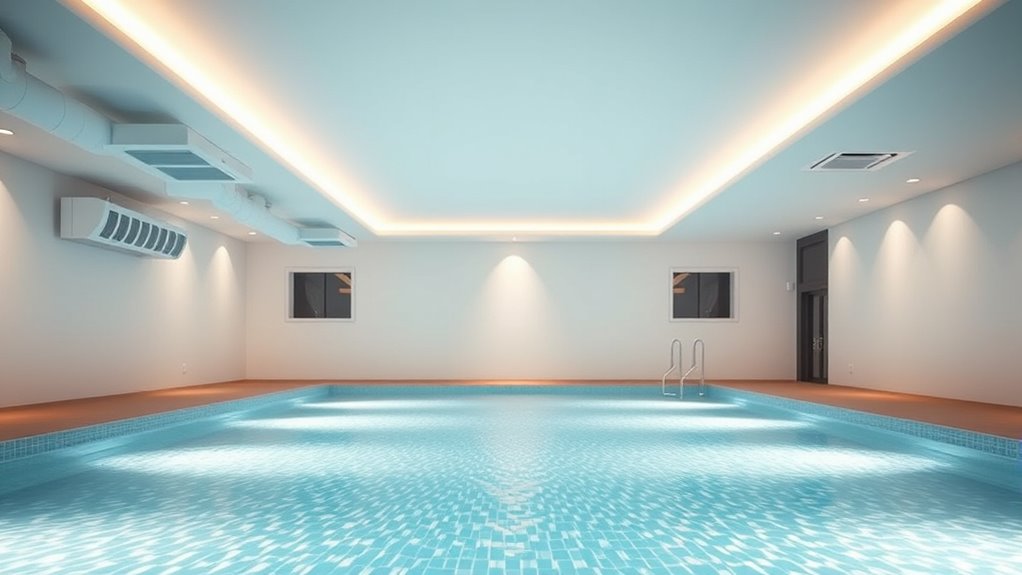
A pool dehumidification system relies on several key components working together to control indoor moisture effectively. The core element is the dehumidifier, which extracts excess humidity from the air, maintaining a comfortable and safe environment. You’ll also need a sensible heat exchanger or condenser, which cools the moist air, causing water to condense and drain away. To circulate air efficiently, you use fans or blowers that move air through the dehumidifier and back into the space. Ductwork connects these components, ensuring proper airflow and moisture removal. A control system monitors humidity levels, automatically turning the dehumidifier on or off to maintain ideal conditions. Understanding bank SWIFT/BIC codes can also help ensure secure financial transactions related to pool maintenance and upgrades. These components work in harmony, preventing excess moisture, mold growth, and structural damage in your indoor pool area.
How Airflow Affects Indoor Pool Environments

Proper airflow is essential for maintaining good air quality and comfort around your indoor pool. It influences how well humidity is controlled and how fresh the air remains. By understanding circulation and humidity strategies, you can create a healthier, more enjoyable swimming environment. Incorporating appropriate ventilation techniques can further optimize air movement and maintain optimal conditions for your indoor pool.
Circulation and Air Quality
Effective circulation plays a crucial role in maintaining air quality in indoor pools, as it helps remove humidity, chloramine fumes, and airborne contaminants. When your ventilation system moves air efficiently, it prevents the buildup of harmful substances that can cause respiratory issues or discomfort. Proper airflow ensures fresh air replaces stale, contaminated air, reducing odors and improving overall environment quality. It also helps distribute chemicals evenly, minimizing localized concentrations of chloramines that form from chlorine reactions. You should regularly check that your ventilation fans, vents, and air ducts are functioning correctly to maintain ideal airflow. Good circulation not only enhances comfort but also supports healthier indoor conditions, making your pool environment safer and more enjoyable for everyone. Using specialized dehumidification systems can further optimize air quality and humidity control in your indoor pool area.
Humidity Control Strategies
Since airflow directly influences humidity levels in indoor pools, controlling ventilation effectively is essential to prevent excessive moisture buildup. You should guarantee proper airflow to remove humid air and introduce drier, filtered air from outside or dehumidifiers. Use exhaust fans strategically to vent moist air directly outside, especially near the pool area. Installing air handlers with humidistats helps maintain consistent humidity levels. Proper airflow also reduces condensation on walls and ceilings, preventing mold growth and structural damage. Balance is key—too much ventilation can lower temperature and cause discomfort, while too little allows humidity to rise. Regularly monitor humidity levels with sensors, adjusting ventilation and dehumidification systems as needed. Effective airflow control creates a comfortable, safe environment for your indoor pool. Quality assessment ensures that ventilation systems operate efficiently and reliably over time.
Selecting the Right Dehumidifier for Your Space

Choosing the right dehumidifier starts with considering the capacity and size for your pool space to guarantee effective moisture control. You’ll also want to compare energy efficiency options to save on long-term costs. Making informed decisions here helps keep your indoor pool comfortable and well-maintained. Additionally, reviewing cost‑of‑ownership details can help you select a model that balances performance with affordability over time.
Capacity and Size
Selecting the right dehumidifier for your indoor pool area depends on understanding the space’s size and moisture levels. To determine the appropriate capacity, measure the room’s square footage and ceiling height. Larger spaces need higher-capacity units that can remove more moisture efficiently. Consider the dehumidifier’s pint-per-day rating; for a typical home pool, a unit with at least 50-70 pints per day is recommended. If your space is small or well-ventilated, a lower-capacity model might suffice. Conversely, high humidity levels or poorly ventilated rooms require larger units. Proper sizing guarantees effective moisture control without overworking the system. Keep in mind that a dehumidifier that’s too small won’t handle the humidity, while an oversized one may cycle too often and waste energy. Additionally, selecting a unit with features like automatic humidity control can optimize performance and energy efficiency.
Energy Efficiency Choices
To maximize energy efficiency when managing your indoor pool’s humidity, it’s important to pick a dehumidifier designed for low power consumption. Look for models with Energy Star certification, which indicates they meet strict efficiency standards. Variable-speed compressors and smart controls can adjust operation based on humidity levels, reducing unnecessary energy use. Smaller, more efficient units are better for moderate humidity, while larger units may be necessary for high moisture levels. Regular maintenance, such as cleaning filters and coils, also helps keep energy consumption low. Consider the dehumidifier’s capacity relative to your space; oversizing wastes energy, while undersizing leaves humidity uncontrolled. Making smart, informed choices guarantees your pool stays comfortable without driving up your energy bills. Additionally, selecting a unit with advanced control systems can optimize performance and further reduce energy costs.
Installing and Positioning Dehumidification Equipment
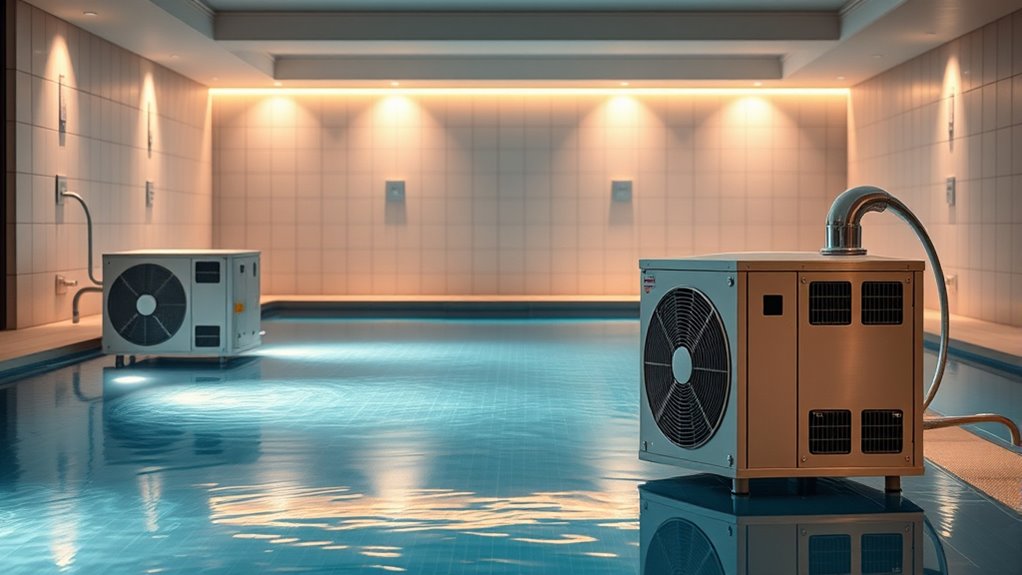
Proper installation and positioning of dehumidification equipment are essential for maintaining ideal humidity levels in your indoor pool area. You should place the dehumidifier in a location with good airflow, ideally away from corners or obstructed by furniture, to guarantee even moisture removal. Elevate the unit slightly off the floor to prevent dust intake and facilitate drainage if necessary. Keep the exhaust vents clear of obstructions to maximize efficiency. Position the dehumidifier so that it can evenly circulate air without creating drafts or temperature inconsistencies. Ensure the unit is connected to a proper power source and that drainage options are accessible for continuous operation. Correct placement not only improves dehumidification performance but also extends the lifespan of your equipment.
Ventilation Strategies for Indoor Pool Areas
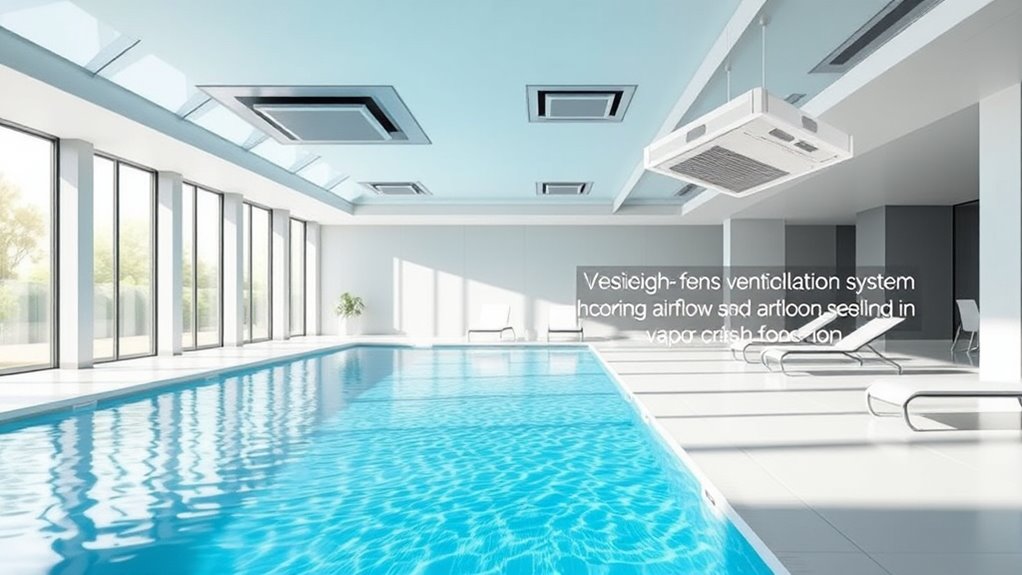
Effective ventilation is key to maintaining a comfortable and healthy indoor pool environment. Proper airflow controls humidity, reduces odors, and minimizes airborne contaminants. To maximize ventilation, consider strategies like balanced mechanical systems and targeted exhaust fans. These methods ensure fresh air circulates efficiently without disrupting temperature or humidity levels. Here’s a quick comparison:
| Strategy | Benefits |
|---|---|
| Exhaust fans | Remove moisture and odors quickly |
| Mechanical ventilation | Continuous fresh air supply |
| Air distribution systems | Even airflow and temperature control |
| Ventilation zoning | Targeted airflow in specific areas |
| Humidistats and sensors | Automated control for optimal balance |
Implementing proper ventilation techniques can significantly improve indoor air quality and overall comfort. Choose a combination that fits your space, ensuring the air stays fresh, and your indoor pool environment remains comfortable.
Managing Moisture Levels to Prevent Damage and Mold
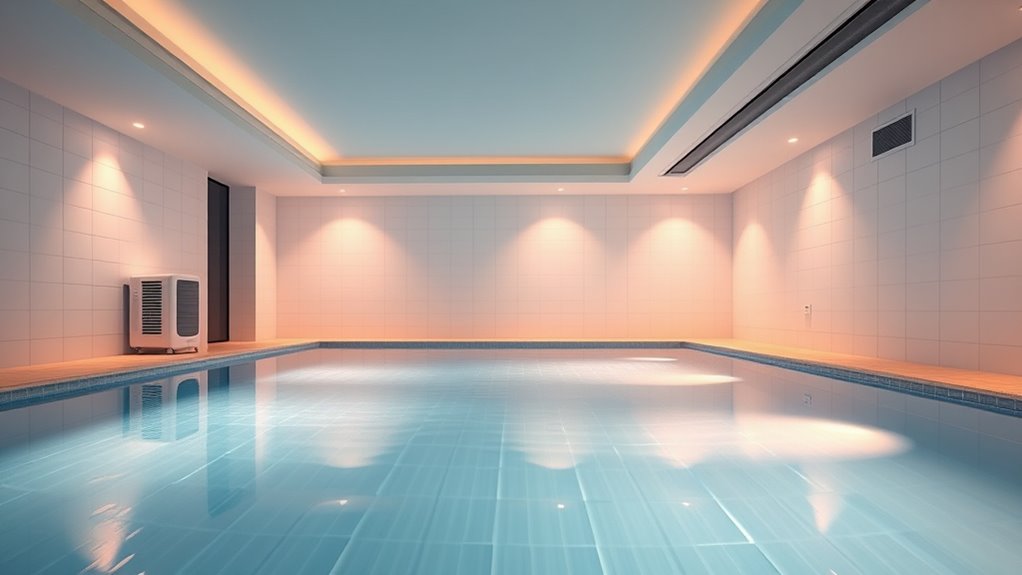
Keeping your indoor pool area dry is essential to prevent damage and mold. You should regularly monitor indoor humidity levels and adjust your ventilation accordingly. Implementing effective ventilation strategies helps maintain a healthy, mold-free environment. Using a dedicated air purifier with HEPA filtration can further improve air quality by removing allergens and airborne pollutants that can contribute to mold growth.
Monitoring Indoor Humidity
Have you ever wondered how indoor humidity levels can impact your pool area? Monitoring humidity is essential to maintaining a safe, comfortable environment. You should regularly check your indoor humidity with a hygrometer, a simple device that measures moisture levels. Aim to keep humidity between 50% and 60%, which prevents mold growth and wood damage. If levels are too high, you might notice musty odors, condensation, or foggy windows. Conversely, low humidity can cause dryness and discomfort. Keep a close eye on these readings, especially during peak pool use or in humid seasons. Consistent monitoring helps you identify trends and adjust your dehumidification system proactively, ensuring your indoor pool remains a safe, healthy space without risking moisture-related issues.
Effective Ventilation Strategies
Since indoor pools introduce significant moisture into your space, managing ventilation is crucial to prevent damage and mold growth. You need to guarantee continuous airflow to remove excess humidity effectively. Use an exhaust fan designed for high moisture areas, and run it during and after pool use to vent moist air outside. Consider installing a heat recovery ventilator (HRV) or energy recovery ventilator (ERV) to exchange stale indoor air with fresh outdoor air without losing energy. Keep doors and windows open when possible, especially after swimming sessions. Proper airflow prevents condensation on walls, ceilings, and windows, reducing mold risk. Regularly check and maintain your ventilation systems to ensure they operate efficiently. Effective ventilation is essential for a healthy, damage-free indoor pool environment.
Maintaining Air Quality and Circulation
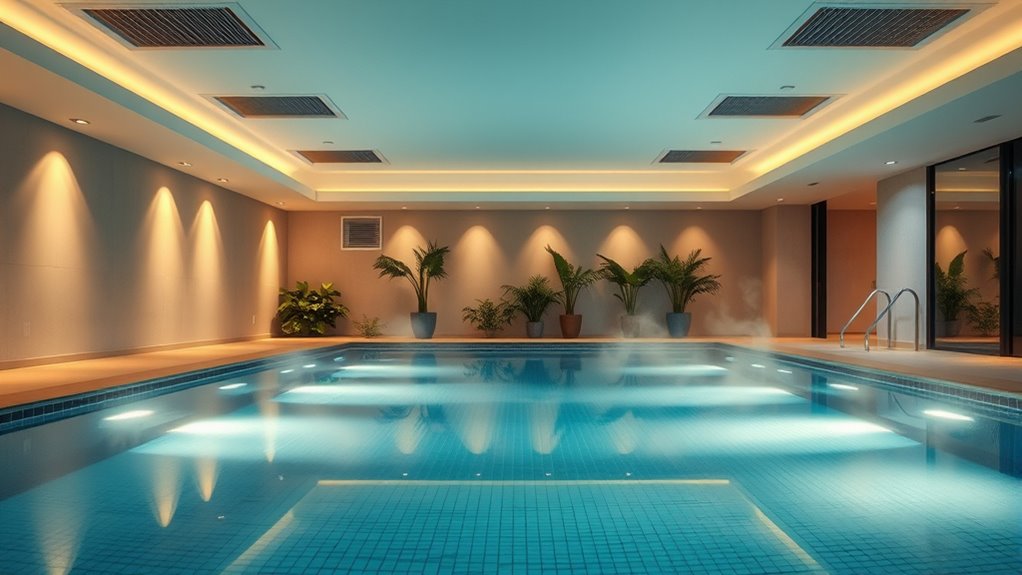
Effective air quality and circulation are essential for creating a safe and comfortable indoor pool environment. You need to guarantee fresh air constantly flows in, removing airborne contaminants like chlorine fumes, humidity, and odors. Proper airflow helps prevent mold growth and reduces the risk of respiratory issues. Use exhaust fans and ventilation systems to exchange stale indoor air with fresh outdoor air regularly. Keep air filters clean to trap dust and pollutants, maintaining a healthy atmosphere. Additionally, position air vents strategically to promote even circulation, avoiding stagnant pockets of air. Monitoring air quality with sensors can alert you to increasing levels of humidity or pollutants. Consistent maintenance of your ventilation system keeps air fresh, breathable, and safe for everyone enjoying your indoor pool.
Energy Efficiency Tips for Dehumidification and Ventilation
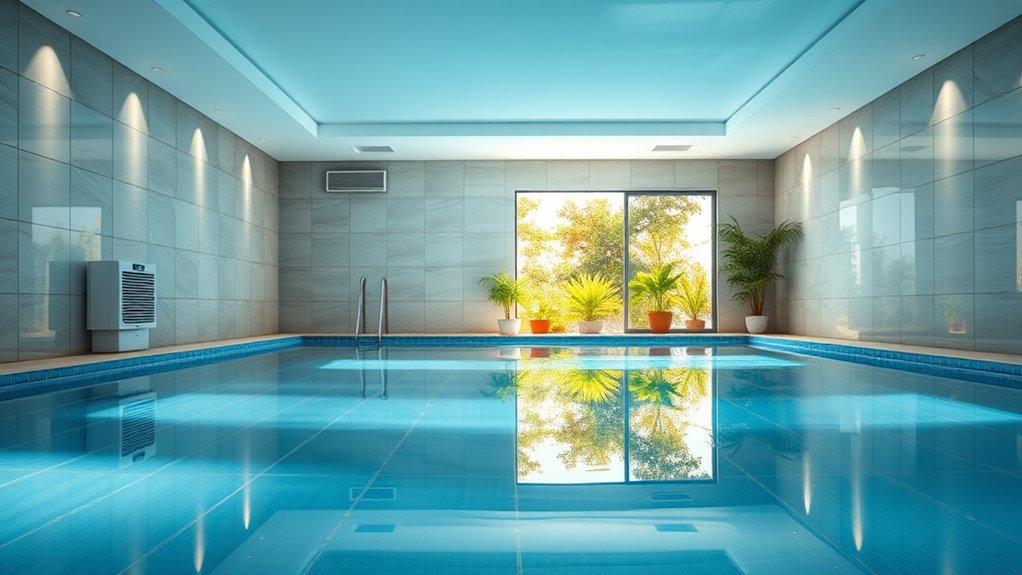
To maximize energy efficiency in your indoor pool’s dehumidification and ventilation systems, you should select appropriately sized equipment and optimize its operation. Properly sized units prevent overworking or underperforming, saving energy and reducing utility costs. Use programmable controls to run systems only when needed, such as during peak humidity or occupancy times. Regularly maintain filters, coils, and fans to ensure they operate smoothly and efficiently. Consider integrating sensors that adjust ventilation based on real-time humidity and air quality levels, preventing unnecessary airflow. Also, seal leaks and insulate ducts to minimize energy loss. By fine-tuning your equipment and maintaining it well, you can attain effective humidity control while keeping energy consumption low, ultimately saving money and promoting a more sustainable indoor environment.
Common Mistakes to Avoid in Indoor Pool Humidity Management
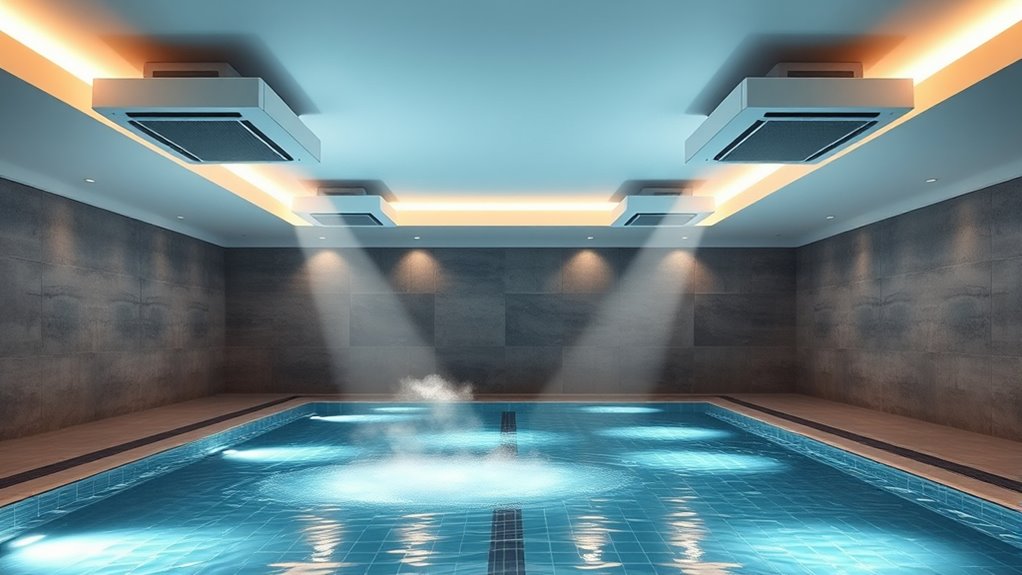
While improving your dehumidification and ventilation systems is key to energy efficiency, overlooking common mistakes can undermine your efforts. One mistake is setting the humidity levels too low, which can cause dry air and discomfort. Another is under-ventilating, leading to excess moisture buildup. Overusing dehumidifiers without proper airflow can also waste energy and reduce effectiveness. Additionally, ignoring regular maintenance, like cleaning filters, hampers performance. Lastly, neglecting proper air circulation patterns allows stale air to linger, creating mold risks. To help visualize, consider this table:
| Mistake | Consequence | Solution |
|---|---|---|
| Setting humidity too low | Dry air, discomfort | Find suitable humidity levels |
| Under-ventilating | Excess moisture, mold risk | Ensure proper airflow |
| Overusing dehumidifiers | Higher energy costs | Use control systems wisely |
| Ignoring maintenance | Reduced efficiency | Schedule regular checks |
| Poor air circulation | Stale air, mold, odors | Maximize airflow patterns |
Frequently Asked Questions
How Often Should Indoor Pool Dehumidifiers Be Serviced?
You should service your indoor pool dehumidifier at least once a year to guarantee peak performance. Regular maintenance includes cleaning filters, inspecting hoses, and checking for any leaks or wear. If your pool is used heavily or the environment is very humid, consider more frequent checks—every six months. Proper servicing helps prevent mold, maintains air quality, and extends the lifespan of your dehumidification system.
What Safety Precautions Are Necessary for Dehumidifier Installation?
You should guarantee the dehumidifier installation is safe by turning off power before starting, using proper electrical wiring, and following manufacturer instructions. Wear protective gear, such as gloves and goggles, to prevent injury. Confirm the unit is grounded correctly to avoid electrical hazards. Keep the area dry and clear of obstructions, and consider hiring a licensed professional for complex setups. Regularly inspect the installation for any signs of damage or wear.
Can Portable Dehumidifiers Effectively Control Humidity in Large Pools?
Did you know a single 12×24 foot pool can produce over 4 gallons of water vapor hourly? Portable dehumidifiers can help control humidity, but they often struggle with large pools. Their capacity might be insufficient to manage the moisture effectively, leading to mold and damage. For larger pools, you’ll need a dedicated, whole-room dehumidification system to maintain ideal humidity levels and guarantee safety and comfort.
How Do Outdoor Weather Conditions Influence Indoor Humidity Management?
Outdoor weather conditions profoundly influence your indoor humidity management. When it’s hot and humid outside, moisture enters your space more easily, making dehumidification necessary. Conversely, cold, dry weather can reduce indoor humidity naturally, easing your dehumidification needs. Rainy or stormy conditions increase indoor moisture levels, requiring more active control. You should monitor weather forecasts regularly and adjust your dehumidification systems accordingly to maintain ideal indoor air quality and comfort.
Are There Eco-Friendly Options for Indoor Pool Dehumidification Systems?
Yes, you can choose eco-friendly dehumidification options for your indoor pool. Look for systems with energy-efficient features like heat recovery or eco-conscious refrigerants. Some models use renewable energy sources or incorporate solar power, reducing your carbon footprint. Additionally, opting for high-efficiency desiccant dehumidifiers can lower energy consumption. These choices help you maintain ideal humidity levels while being environmentally responsible, saving energy and reducing greenhouse gas emissions.
Conclusion
Just as Daedalus crafted wings to navigate the skies, mastering dehumidification lets you control your indoor pool’s environment with confidence. By understanding airflow, selecting the right equipment, and maintaining proper humidity, you create a sanctuary that’s safe and inviting. Remember, neglecting these essentials is like Icarus flying too close to the sun—risking damage and discomfort. Stay vigilant, and your indoor oasis will remain a haven of balance and beauty.
